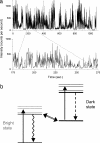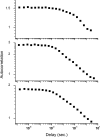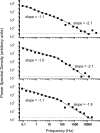Evidence for a diffusion-controlled mechanism for fluorescence blinking of colloidal quantum dots
- PMID: 17720807
- PMCID: PMC1964845
- DOI: 10.1073/pnas.0706164104
Evidence for a diffusion-controlled mechanism for fluorescence blinking of colloidal quantum dots
Abstract
Fluorescence blinking in nanocrystal quantum dots is known to exhibit power-law dynamics, and several different mechanisms have been proposed to explain this behavior. We have extended the measurement of quantum-dot blinking by characterizing fluctuations in the fluorescence of single dots over time scales from microseconds to seconds. The power spectral density of these fluctuations indicates a change in the power-law statistics that occurs at a time scale of several milliseconds, providing an important constraint on possible mechanisms for the blinking. In particular, the observations are consistent with the predictions of models wherein blinking is controlled by diffusion of the energies of electron or hole trap states.
Conflict of interest statement
The authors declare no conflict of interest.
Figures





Similar articles
-
A common mechanism underlies the dark fraction formation and fluorescence blinking of quantum dots.ACS Nano. 2009 May 26;3(5):1167-75. doi: 10.1021/nn800684z. ACS Nano. 2009. PMID: 19385605
-
A guide to accurate measurement of diffusion using fluorescence correlation techniques with blinking quantum dot nanoparticle labels.J Chem Phys. 2008 Jun 14;128(22):225105. doi: 10.1063/1.2918273. J Chem Phys. 2008. PMID: 18554062
-
Blinking suppression in CdSe/ZnS single quantum dots by TiO2 nanoparticles.ACS Nano. 2010 Aug 24;4(8):4445-54. doi: 10.1021/nn100698u. ACS Nano. 2010. PMID: 20731430
-
Blinking statistics of silicon quantum dots.Nano Lett. 2011 Dec 14;11(12):5574-80. doi: 10.1021/nl203618h. Epub 2011 Nov 23. Nano Lett. 2011. PMID: 22107270
-
Fluorescence correlation spectroscopy using quantum dots: advances, challenges and opportunities.Phys Chem Chem Phys. 2007 Apr 28;9(16):1870-80. doi: 10.1039/b617115j. Epub 2007 Mar 2. Phys Chem Chem Phys. 2007. PMID: 17431516 Review.
Cited by
-
Second harmonic generating (SHG) nanoprobes for in vivo imaging.Proc Natl Acad Sci U S A. 2010 Aug 17;107(33):14535-40. doi: 10.1073/pnas.1004748107. Epub 2010 Jul 28. Proc Natl Acad Sci U S A. 2010. PMID: 20668245 Free PMC article.
-
In Operando Characterization and Control over Intermittent Light Emission from Molecular Tunnel Junctions via Molecular Backbone Rigidity.Adv Sci (Weinh). 2019 Aug 22;6(20):1900390. doi: 10.1002/advs.201900390. eCollection 2019 Oct 16. Adv Sci (Weinh). 2019. PMID: 31637155 Free PMC article.
-
Interaction of theory and experiment: examples from single molecule studies of nanoparticles.Philos Trans A Math Phys Eng Sci. 2010 Mar 13;368(1914):1109-24. doi: 10.1098/rsta.2009.0261. Philos Trans A Math Phys Eng Sci. 2010. PMID: 20123749 Free PMC article.
-
Unique temporal and spatial biomolecular emission profile on individual zinc oxide nanorods.Nanoscale. 2014 Jan 7;6(1):308-15. doi: 10.1039/c3nr05031a. Epub 2013 Nov 6. Nanoscale. 2014. PMID: 24193145 Free PMC article.
-
Correlated Single Quantum Dot Blinking and Interfacial Electron Transfer Dynamics.Chem Sci. 2010 Aug 31;1(4):519-526. doi: 10.1039/C0SC00334D. Chem Sci. 2010. PMID: 21915369 Free PMC article.
References
-
- Murray CB, Norris DJ, Bawendi MG. J Am Chem Soc. 1993;115:8706–8715.
-
- Hines MA, Guyot-Sionnest P. J Phys Chem. 1996;100:468–471.
-
- Colvin VL, Schlamp MC, Alivisatos AP. Nature. 1994;370:354–357.
-
- Eisler H-G, Sundar VC, Bawendi MG, Walsh M, Smith HI, Klimov V. Appl Phys Lett. 2002;80:4614–4616.
-
- Bruchez M, Moronne M, Gin P, Weiss S, Alivisatos AP. Science. 1998;281:2013–2016. - PubMed
Publication types
MeSH terms
Substances
Grants and funding
LinkOut - more resources
Full Text Sources
Other Literature Sources
Molecular Biology Databases

